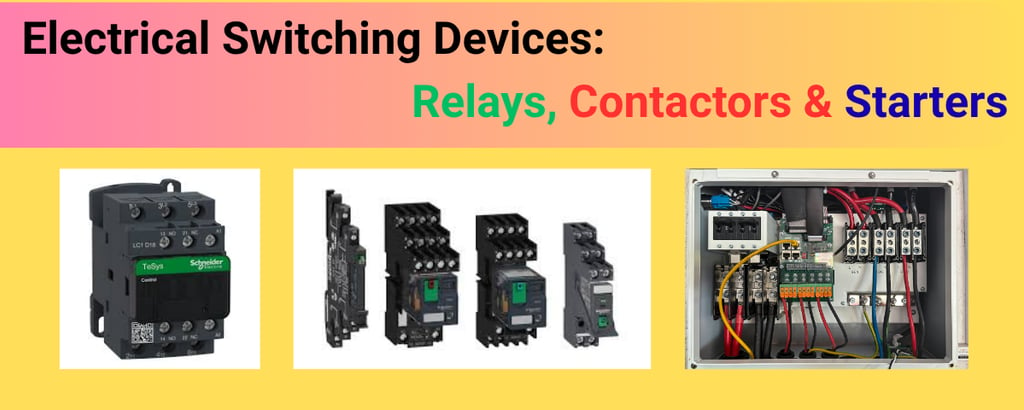Exciting News: E-Books Launching Soon !!
Understanding Electrical Switching Devices: Relays, Contactors & Starters
This blog explains the roles and differences between relays, contactors, and starters—three essential switching devices in electrical systems. It covers their working principles, applications, and how to choose the right one for safe and efficient operation.


What Are Switching Devices?
(स्विचिंग डिवाइसेस क्या होती हैं)
Switching devices are components used to control the flow of electricity by opening or closing electrical circuits. These devices are fundamental in automation systems, motor control, and protection mechanisms. They ensure that electrical equipment operates safely and efficiently.
In any electrical setup—whether industrial or residential—switching devices play a key role in managing power distribution, controlling machinery, and protecting equipment from faults. The three most commonly used switching devices are:
Relays (रिले): Used for low-current control and logic operations.
Contactors (कॉन्टैक्टर): Designed for switching high-power loads like motors and heaters.
Starters (स्टार्टर): Combine switching with motor protection features such as overload safety and soft-start capabilities.
⚙️ Relays: The Brain of Control Circuits
Relays are electromechanical or solid-state devices that control circuits using low-power signals. They are widely used in automation systems, control panels, and logic circuits. A relay works by using a small input current to activate a switch that controls a larger current in another circuit.
Applications of Relays:
Programmable Logic Controllers (PLCs)
Alarm systems
Timers and indicators
Signal switching in automation
Advantages of Relays:
Fast switching speed
Electrical isolation between control and load circuits
Compact and cost-effective
Suitable for repetitive operations
Limitations: Relays are not designed to handle high currents or inductive loads like motors. They also lack built-in protection features, which means external devices must be used to safeguard the circuit.
⚙️ Contactors: Heavy-Duty Switching Devices
Contactors are robust switching devices used to control high-power electrical loads. Unlike relays, contactors are built to handle large currents and voltages, making them ideal for industrial applications.
Working Principle: A contactor operates using an electromagnetic coil that pulls contacts together to complete a circuit. When the coil is energized, the contacts close, allowing current to flow to the load. When de-energized, the contacts open, breaking the circuit.
Applications of Contactors:
Motor control (pumps, compressors, fans)
Industrial lighting systems
Heating elements
HVAC systems
Advantages of Contactors:
Designed for high current and voltage
Durable and reliable under heavy loads
Can be used with auxiliary contacts for control logic
Suitable for both resistive and inductive loads
Limitations: Contactors usually do not include overload protection. They require external protective devices like thermal overload relays or circuit breakers. Also, they are not suitable for high-frequency switching operations.
⚙️ Starters: Smart Motor Controllers
Starters are specialized devices used to start and stop motors safely. They not only switch the motor on and off but also protect it from electrical faults such as overload, under-voltage, and short circuits.
Types of Starters:
DOL (Direct-On-Line) Starter:
Simplest and most cost-effective
Connects motor directly to power supply
High inrush current during startup
Suitable for small motors
Star-Delta Starter:
Reduces inrush current by starting in star configuration and then switching to delta
Ideal for medium to large motors
Requires more wiring and space
Soft Starter:
Gradually increases voltage to the motor during startup
Reduces mechanical stress and electrical surges
Offers smooth acceleration and deceleration
Suitable for sensitive machinery
Applications of Starters:
Conveyor systems
Elevators and lifts
Compressors
HVAC fans
Industrial machinery
Advantages of Starters:
Built-in overload protection
Smooth motor operation
Enhanced safety features
Prolongs motor life
Limitations: Starters are more complex and expensive than relays and contactors. They require proper configuration and may need additional components for advanced control.
🔍 Key Differences Between Relays, Contactors & Starters
While all three devices perform switching functions, their capabilities and applications differ significantly:
Relays are best for low-current control tasks and automation logic.
Contactors are suitable for switching high-power loads but need external protection.
Starters offer both switching and protection, making them ideal for motor control.
Each device has its own operating range, switching frequency, and protection features. Choosing the right one depends on the load type, current rating, and safety requirements.
🛠️ Why Choosing the Right Device Matters
Selecting the wrong switching device can lead to serious issues:
Efficiency Loss: Using a relay for a high-power load can cause overheating and energy waste.
Premature Failure: Contacts may get damaged due to excessive current, leading to frequent replacements.
Safety Hazards: Lack of proper protection can result in electrical fires or equipment damage.
Higher Costs: Increased maintenance and downtime raise the total cost of ownership.
📌 Where Each Device Excels
Relays shine in control panels, automation systems, and signal switching. They are perfect for tasks that require frequent switching at low currents.
Contactors are the go-to choice for industrial applications involving motors, lighting banks, and heating systems. They offer reliable performance under heavy electrical loads.
Starters are essential for motor-driven equipment where safety during startup is critical. They provide overload protection, smooth acceleration, and enhanced control features.
🧠 Understanding Load Types & Switching Needs
Different electrical loads require different switching strategies:
Resistive Loads: Such as lighting and heating elements, are easier to switch and don’t produce inrush currents.
Inductive Loads: Like motors and transformers, generate high inrush currents and back-EMF, requiring robust switching devices.
